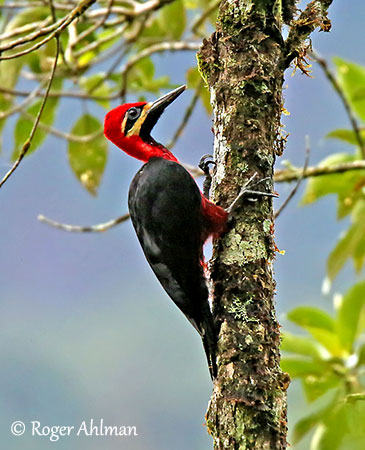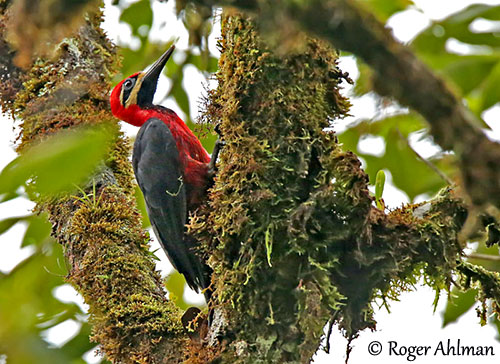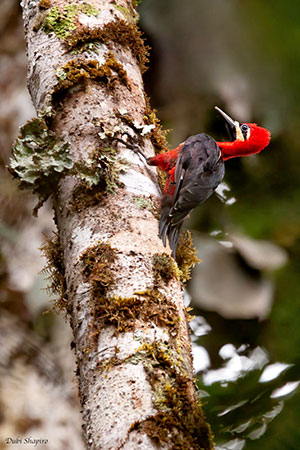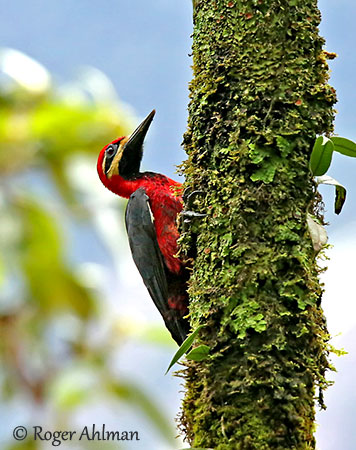
Fr: Pic superbe
Ang: Crimson-bellied Woodpecker
All: Blutbauchspecht
Esp: Picamaderos Ventrirrojo
Ita: Picchio panciacremisi
Nd: Grote Roodbuikspecht
Sd: karmosinspett
Photographers:
Roger Ahlman
Pbase Galleries Peru and Ecuador
Dubi Shapiro
Dubi Shapiro Photo Galleries
Text by Nicole Bouglouan
Sources:
HANDBOOK OF THE BIRDS OF THE WORLD Vol. 7 by Josep del Hoyo-Andrew Elliott-Jordi Sargatal – Lynx Edicions – ISBN: 8487334377
Woodpeckers of the World: The Complete Guide by Gerard Gorman – Editeur: A&C Black, 2014 – Helm Photographic Guides - ISBN: 1408147173, 9781408147177
WOODPECKERS, an identification guide of the woodpeckers of the world by Winkler Hans and Christie David – Helm – ISBN: 0395720435
BIRDS OF PERU by Thomas S. Schulenberg, Douglas F. Stotz, Daniel F. Lane, John P. O’Neill, Theodore A. Parker III – Princeton University Press 2007– ISBN: 978-0-691-13023-1
A GUIDE TO THE BIRDS OF COLOMBIA by Steven L. Hilty and William L. Brown - Princeton University Press – ISBN 069108372X
BirdLife International (haematogaster)
BirdLife International (splendens)
Wikipedia, the free encyclopaedia
Crimson-bellied Woodpecker
Campephilus haematogaster
Piciformes Order – Picidae Family
INTRODUCTION:
The Crimson-bellied Woodpecker is found in Central and South America along the east slope of the Andes. It is present in Panama, Colombia, Ecuador and Peru where it frequents wet forest and forest edges from lowlands to 1,500/2,000 metres of elevation.
It feeds on large beetles by hammering and probing in bark crevices in trees.
It typically nests in natural cavity excavated in large tree.
The Crimson-bellied Woodpecker is described as uncommon. The race C.h. splendens is listed as Near Threatened, whereas the race C.h. haematogaster is evaluated as Least Concern.
DESCRIPTION OF THE BIRD:
Biometrics:
Length: 33-35 cm
Weight: 225-250 g
The Crimson-bellied Woodpecker male of nominate race has black to brownish-black mantle, scapulars and upper back, whereas lower back and rump are red. Both uppertail-coverts and uppertail are black. On the black to brownish-black upperwing, the primaries show narrow pale tips in fresh plumage. There are two white spots on the inner webs of the secondaries and all primaries except the outermost flight-feathers.
The underparts are tinged crimson and black. The underwing is blackish with pale barring, but the coverts are white.

On the head, we can see a black mask contrasting with the pale buff face. There is a narrow pale buff supercilium behind the eye and a broad, buff cheek band extending from forehead to lower cheek. A thin, black line extends above the pale supercilium. Crown, nape, hindneck and neck are red. Chin and throat are black. A large, red, pointed crest is visible at the top of the head.
The long, chisel-tipped bill is blackish with a fairly broad part across the nostrils. The eyes are reddish-brown, surrounded by bare, greyish-black orbital ring. Legs and feet are greyish-black.
The Crimson-bellied Woodpecker in worn plumage is duller, with browner dark areas and duller red areas. On crown and underparts, the black feather bases are visible.
The female resembles male but the pale buff cheek band extends broadly down the sides of the neck to the shoulders.
The juvenile has duller plumage than adults. The black areas are browner, the underparts are less red and the forehead is tinged sooty.
SUBSPECIES AND RANGE:
The Crimson-bellied Woodpecker has two subspecies, although the race C.h. splendens is sometimes considered a separate species named Splendid Woodpecker.
C.h. haematogaster (described above) is found on the E slope of the Andes of E Colombia and E Ecuador to E Peru.
C.h. splendens occurs in Panama and W Colombia to W Ecuador.
This one has three large buff spots on the flight-feathers (only two white spots in nominate race). The male shows red (not black) on lower throat to upper breast and the crown is deeper scarlet. The underparts are black and more barred and mottled.
HABITAT:
The Crimson-bellied Woodpecker is usually uncommon and rare in humid montane forest and forest edges. However, it occurs more often within the tall forest. It also frequents foothills from 1,000 to 1,700 metres in Ecuador, and between 900 and 1,100 metres in Colombia, and around 800 metres in W Ecuador.

CALLS AND SONGS: SOUNDS BY XENO-CANTO
The call of the Crimson-bellied Woodpecker is a high, squeaky “psit” but we can also hear a longer, squeaky rattle “psit-trr’r’r’r” lasting about two seconds. It performs the usual “double-rap” drum, typical of Campephilus species.
The race “splendens” gives a loud “psit”. The song consists of repeated, harsh, nasal, loud “eer” notes. The drum is a heavy, quick “double-rap” like nominate race.
BEHAVIOUR IN THE WILD:
The Crimson-bellied Woodpecker feeds on large beetles and large larvae of wood-boring insects.
It usually forages close to the ground. It hammers and probes in bark crevices on trunks of large trees within the dense forest. In more open areas, it may forage slightly higher above the ground.
This species is usually seen alone, less often in pairs.
The race “splendens” also feeds on Coleopterans, both adults and larvae.
It forages at low level in large trees, solitary or in pairs.
The Crimson-bellied Woodpecker typically nests in tree cavity excavated by both adults.
The nesting behaviour of this species is poorly known. Drumming is used to advertise the territory. During the courtship displays, the red crest and rump are probably exposed and the tail is spread. This behaviour is often accompanied by calls.

Both subspecies are resident in their range.
While in flight, the pale barring of the flight-feathers is conspicuous. Like most Picidae species, the Crimson-bellied Woodpecker has undulating flight.
REPRODUCTION OF THIS SPECIES:
The nesting season varies depending on the range. The nominate race breeds between September and April in Colombia and Ecuador. The race “splendens” breeds from March to May in Panama.
Like most Picidae, the Crimson-bellied Woodpecker excavates a nesting hole in tree trunk. Usually, both adults share the nesting duties. They are monogamous.
No more information.
PROTECTION / THREATS / STATUS:
The Crimson-bellied Woodpecker of nominate race is described as uncommon to locally common in Colombia, rare to locally uncommon in Ecuador and rare in Peru.
The population is suspected to be declining slowly, due to degradation and loss of the habitat. However, it is not globally threatened and currently evaluated as Least Concern.
The Crimson-bellied Woodpecker of race “splendens” is threatened by intensive logging, human settlement, continuing loss and degradation of the habitat, cattle-grazing, mining activities and cultivation.
The population is suspected to be declining, but the species appears to be able to adapt to forest edge habitats. In addition, it frequents forests at mid-elevations, usually more secure than lowland forests.The race “splendens” is currently listed as Near Threatened.
